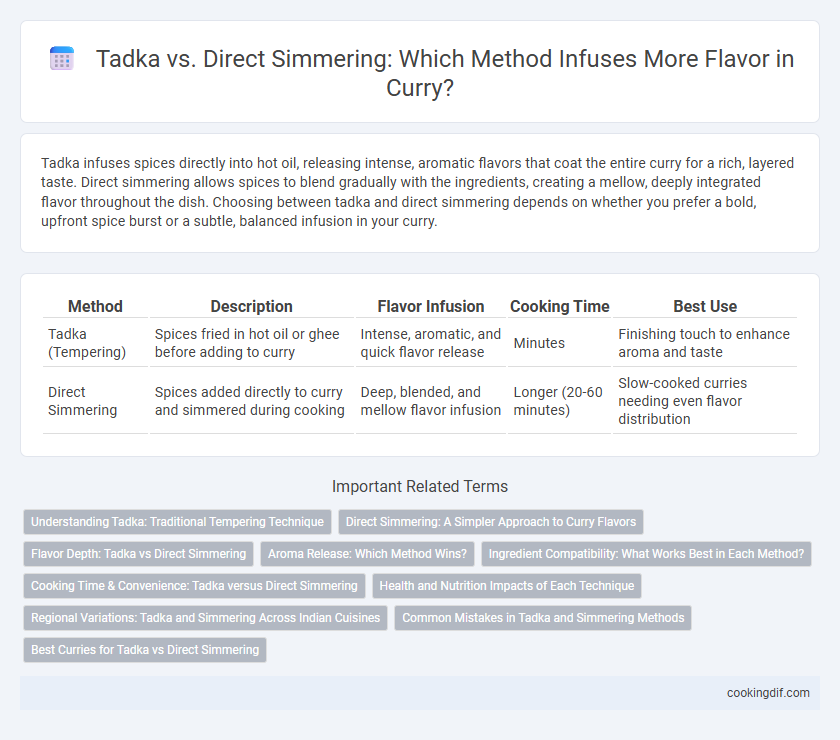Tadka infuses spices directly into hot oil, releasing intense, aromatic flavors that coat the entire curry for a rich, layered taste. Direct simmering allows spices to blend gradually with the ingredients, creating a mellow, deeply integrated flavor throughout the dish. Choosing between tadka and direct simmering depends on whether you prefer a bold, upfront spice burst or a subtle, balanced infusion in your curry.
Table of Comparison
| Method | Description | Flavor Infusion | Cooking Time | Best Use |
|---|---|---|---|---|
| Tadka (Tempering) | Spices fried in hot oil or ghee before adding to curry | Intense, aromatic, and quick flavor release | Minutes | Finishing touch to enhance aroma and taste |
| Direct Simmering | Spices added directly to curry and simmered during cooking | Deep, blended, and mellow flavor infusion | Longer (20-60 minutes) | Slow-cooked curries needing even flavor distribution |
Understanding Tadka: Traditional Tempering Technique
Tadka, also known as tempering, is a traditional Indian cooking technique where whole spices are briefly roasted in hot oil or ghee to release their essential oils and enhance their aromatic profile. This method infuses rich, layered flavors directly into the oil, which then disperses uniformly throughout the curry, creating a more intense and complex taste compared to direct simmering. Unlike direct simmering where spices are cooked slowly within the liquid, tadka provides a burst of freshly toasted spice notes that elevate the dish's overall flavor and aroma.
Direct Simmering: A Simpler Approach to Curry Flavors
Direct simmering allows curry spices to slowly infuse into the sauce, creating a deeper, more harmonious flavor compared to the sharp bursts from tadka. This method involves cooking ingredients together over low heat, which enhances the melding of spices and aromatics naturally. Simplifying the process, direct simmering requires less oil and fewer steps, making it an accessible technique for developing rich, layered curry profiles.
Flavor Depth: Tadka vs Direct Simmering
Tadka enhances flavor depth by quickly roasting spices in hot oil, releasing essential oils and aromas that create a vibrant and intense taste profile. Direct simmering allows spices to slowly infuse, resulting in a more subtle and well-rounded flavor that penetrates the entire curry. Combining both techniques can maximize complexity, balancing the immediate aroma from tadka with the lingering richness developed through simmering.
Aroma Release: Which Method Wins?
Tadka enhances aroma release by quickly infusing hot oil with spices, unlocking essential oils that intensify the curry's fragrance. Direct simmering melds flavors slowly but often results in a milder aroma due to lower heat and prolonged cooking. For a vibrant, immediate burst of aroma, tadka proves superior in flavor infusion.
Ingredient Compatibility: What Works Best in Each Method?
Tadka excels with whole spices like cumin, mustard seeds, and dried red chilies, releasing intense aromas when fried in hot oil, making it ideal for dishes requiring bold, layered flavors such as dals and lentil curries. Direct simmering suits delicate ingredients like ground spices, garlic, and ginger, allowing gradual infusion and deeper melding without burning, perfect for creamy, slow-cooked curries and stews. Understanding ingredient compatibility enhances flavor depth by matching robust, heat-tolerant spices with tadka and fragile, slow-infusing components with simmering.
Cooking Time & Convenience: Tadka versus Direct Simmering
Tadka infuses curry flavors quickly by frying spices in hot oil, significantly reducing cooking time compared to direct simmering, which requires longer periods to develop deep, integrated taste. The convenience of tadka lies in its ability to deliver bold, aromatic notes almost instantly, making it ideal for fast meal preparation. In contrast, direct simmering demands patience and continuous monitoring to achieve a well-rounded flavor through slow spice infusion.
Health and Nutrition Impacts of Each Technique
Tadka involves tempering spices in hot oil, which enhances flavor extraction and boosts the absorption of fat-soluble vitamins like A, D, E, and K, though it may increase calorie and saturated fat intake. Direct simmering allows spices to infuse gradually, preserving water-soluble nutrients such as vitamin C and certain B vitamins, while reducing oil consumption and lowering overall fat content. Choosing between these techniques depends on balancing flavor intensity with nutritional goals, as tadka offers richer taste at a potential health cost, whereas simmering supports lighter, nutrient-retentive cooking.
Regional Variations: Tadka and Simmering Across Indian Cuisines
Tadka and direct simmering are two distinct techniques for flavor infusion in Indian curries, with regional preferences shaping their use. In North Indian cuisine, tadka, or tempering spices in hot oil, is commonly employed for dishes like dal tadka and rajma, accentuating the aroma and complexity of spices. In contrast, South Indian and Bengali curries often rely on direct simmering, allowing spices and ingredients to meld gradually, creating a deep, harmonious blend favored in sambar and macher jhol, highlighting regional taste profiles and cooking traditions.
Common Mistakes in Tadka and Simmering Methods
Common mistakes in tadka include overheating the oil, which can burn spices and produce a bitter taste, and adding delicate ingredients too early, leading to loss of aroma. In direct simmering, undercooking spices results in weak flavor infusion, while overcooking can dull complex notes and cause an unbalanced curry. Proper temperature control and timing are crucial to maximize the aromatic potential of both methods.
Best Curries for Tadka vs Direct Simmering
Tadka enhances curries like dal tadka and sambar, where tempering spices in hot oil infuses vibrant aromas and sharp, layered flavors. Direct simmering suits rich, slow-cooked curries such as butter chicken and lamb rogan josh, allowing spices to meld deeply for a smooth, integrated taste. Choosing tadka or direct simmering depends on the curry's spice profile and desired flavor intensity for optimal taste.
Tadka vs Direct simmering for flavor infusion Infographic

 cookingdif.com
cookingdif.com